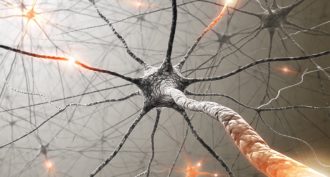MS-LS1-2
Develop and use a model to describe the function of a cell as a whole and ways parts of cells contribute to the function.
-
 Animals
AnimalsPenguins? How tasteless
Penguins may look all dressed up in tuxedo-wear, but their taste buds are the bare minimum. This means that the birds will never sense more than a hint of their meals’ true flavors.
-
 Health & Medicine
Health & MedicineMice can teach us about human disease
Humans and mice look and act very differently. But 85 to 90 percent of their genes are the same or quite similar. So an international group of scientists is deciphering the instructions in mouse genes to help us better understand our own.
-
 Environment
EnvironmentAir pollution can mess with our DNA
New research suggests a type of air pollution — diesel fumes — can affect your health. It inappropriately switches some genes on, while turning off others.
-
 Health & Medicine
Health & MedicineA whale of a lifespan
Bowhead whales can live more than 200 years. The secret to such longevity may lie in the Arctic species’ genes. Scientists recently mapped the whale’s genetic code. They found features that protect the marine mammal against cancer and other problems related to old age.
-
 Computing
ComputingVirtual wounds: Computers probe healing
To better understand how the body heals wounds, scientists have begun creating computer programs that let virtual cells fight it out. These ‘computer games’ could lead to better medicines.
-
 Agriculture
AgricultureLivestock: A need to save rare breeds
New studies and ongoing work highlight why society should save rare livestock breeds — and the part that technology can play.
-
 Brain
BrainLearning rewires the brain
Brain cells actually change shape as we learn. It’s one way we cement new knowledge. And much of the action happens as we sleep.
-
 Genetics
GeneticsNewfound DNA ‘enhancer’ behind many natural blonds
Some snippets of DNA other than genes play a role in giving some people of European a golden crown of hair.
-
 Health & Medicine
Health & MedicineTeen uncovers new weapons to stop Huntington’s disease
David Seong, an Intel Science Talent Search finalist, is studying how tiny pieces of genetic material might be used to lock up a dangerous protein in Huntington’s disease.
-
 Life
LifeExplainer: What is a stem cell?
Special cells have ability to turn into several different types
-
 Brain
BrainExplainer: Our bodies’ internal clocks
Biological clocks determine hunger, sleepiness and other daily rhythms.
-
 Brain
BrainThe teenage brain
Adolescence triggers brain — and behavioral — changes that few kids or adults understand.